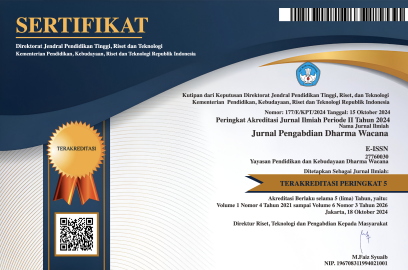Penyusunan Pedoman Pengelolaan Sampah Pantai Minang Rua Sebagai Upaya Mewujudkan Sustainable Tourism
https://doi.org/10.37295/jpdw.v4i4.512
Abstract
This service aims to compile waste management guidelines in Minang Rua Beach tourist destinations as an effort to realize sustainable tourism. Garbage is one of the problems faced by members of the Pokdarwis Minang Rua Beach. The accumulation of the amount of garbage is comparable to the number of tourists on Minang Rua Beach after Covid-19 whose number continues to increase. Garbage sent from other regions carried by the waves of sea water and rivers, also enliven the pile of garbage on this beach. There are no waste management guidelines on Minang Rua Beach, Pokdarwis members independently collect, burn and hoard the waste. The specific target to be achieved in this service is to increase the awareness of the people of Minang Rua Beach about the importance of waste management to support sustainable tourism. The methods and stages of service implementation are carried out through situation analysis (literature and field study), object intervention (socialization and training), evaluation and monitoring. The location of the service is Minang Rua Beach, Klawi Village, Bakauheni District, South Lampung Regency. The result of this service is an increasing concern of various parties such as Pokdarwis, the community around the beach, and Minang Rua Beach tourists to manage waste in appropriate ways so as not to pollute the environment, and there is a guidebook for waste management of Minang Rua Beach as an effort to realize sustainable tourism in the coastal tourist area.
Downloads
References
Al Bahriyatul Baqiroh, N. F. (2019, February 21). Ini Dampak Penimbunan Sampah Terhadap Air Tanah. Bisnis.com. https://ekonomi.bisnis.com/read/20190221/99/891614/ini-dampak-penimbunan-sampah-terhadap-air-tanah
Dileep, M. R. (2007). Tourism and Waste Management: A Review of Implementation of “Zero Waste” at Kovalam. Asia Pacific Journal of Tourism Research Vol. 12 No. 4, https://doi.org/10.1080/10941660701823314.
Elsaid, S., & Aghezzaf, E.-H. (2015). A framework for Sustainable Waste Management: Challanges and Opportunities. Management Research Review Vol. 38 No.10, 1086-1097.
Menlhk. (2020). Rencana Strategis Tahun 2020-2024: Direktorat Jenderal Pengelolaan Sampah, Limbah dan B3. Kementrian Lingkungan Hidup dan Kehutanan.
Meuser, T., & Peinen, C. V. (2013). Sustainable Tourism. In I. Jenkins, & R. Schröder, Sustainability in Tourism: A Multidisciplinary Approach (p. 85). Springer Gabler.
Mowforth, M., & Munt, I. (2008). Tourism and Sustainability: Development, Globalisation, and New Tourism in the Third World (The 3rd Ed.). New York: Routledge.
Mowforth, M., & Munt, I. (2016). Tourism and Sustainability: Development, Globalisation and New Tourism in the Third World (The 4th Ed.). Routledge.
Napid, S., Budi, R. S., & Susanto, E. (2021). PEMBAKARAN SAMPAH ANORGANIK MENIMBULKAN DAMPAK POSITIF DENGAN PEROLEHAN ASAP CAIR BAGI MASYARAKAT LINGKUNGAN IX KECAMATAN AMPLAS.
Saptenno, M. J., Saptenno, L. B., & Timisela, N. R. (2022). Faktor Yang Mempengaruhi Tingkat Kesadarana Masyarakat Pesisir Terhadap Pengelolaan Sampah di Perairan Teluk Ambon Kota Ambon. Jurnal Ilmu Lingkungan, 20(2), 365–374. https://doi.org/10.14710/jil.20.2.365-374
Seadon, J. K. (2010). Sustainable waste management systems. Journal of Cleaner Production , Vol. 18, 1639-1651.
Syafari, J. H. W., X.-Irvan. (2018, January 3). Pasca Tahun Baru, Sampah Pantai Minang Rua Melimpah Ruah. Cendana News. https://www.cendananews.com/2018/01/pasca-tahun-baru-sampah-pantai-minang-rua-melimpah-ruah.html
Weaver, D. (2006). Sustainable Tourism: Theory and Practice. Butterworth-Heinemann: Elsevier.
Zorpas, A. A., Voukkali, I., & Loizia, P. (2015). The impact of tourist sector in the waste management plans. Desalination and Water Treatment Vol. 56, No. 5, https://doi.org/10.1080/19443994.2014.934721.
Downloads
Published
How to Cite
Issue
Section
License
Copyright (c) 2024 Tety Rachmawati, Rahayu Lestari, Nibras Fadhlillah

This work is licensed under a Creative Commons Attribution 4.0 International License.
The copyright of any article on Jurnal Pengabdian Dharma Wacana is fully held by the author under the Creative Commons CC BY-SA license.
- The copyright on each article belongs to the author.
- The authors retain all of their rights to the published work, not limited to the rights set out on this page.
- The author acknowledges that the Jurnal Pengabdian Dharma Wacana was the first to publish under a Creative Commons Attribution 4.0 International (CC BY-SA) license.
- Authors may submit articles separately, arrange for non-exclusive distribution of manuscripts that have been published in this journal into other versions (eg sent to the author's institution repository, publication into books, etc.), acknowledging that the manuscript has been published for the first time in Jurnal Pengabdian Dharma Wacana;
- The author warrants that the original article, written by the author mentioned, has not been previously published, does not contain any unlawful statements, does not violate the rights of others, is subject to copyright which is exclusively held by the author.
- If an article is co-prepared by more than one author, each author submitting a manuscript warrants that he or she has been authorized by all co-authors to agree to the copyright and license notice (agreement) on their behalf, and agrees to notify the co-authors of the terms of this policy. The International Journal of Artificial Intelligence Research will not be held liable for anything that may arise due to the authors' internal disputes.
Licence :
The Jurnal Pengabdian Dharma Wacana is published under the terms of the Creative Commons Attribution 4.0 International License (CC BY-SA). This license permits anyone to:.
- Sharing — copying and redistributing this material in any form or format;
- Adaptation — compose, modify, and create derivatives of this material for any purpose.
Licence :
- Attribution — You must include an appropriate name, include a link to the license, and certify that changes have been made. You can do this in a manner that is appropriate, but does not imply that the licensor endorses you or your use.
- ShareAlike — If you compose, modify, or make derivatives of this material, you must distribute your contribution under the same license as the original material.









